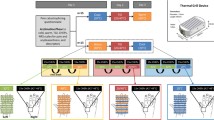Summary
The introduction of lasers in pain research has made it possible to activate the nociceptive system without activating mechanosensitive afferents. In the present study the reaction times to painless and painful laser stimuli were studied to investigate if the reaction time to experimental pain is reproduceable. CO2 and argon lasers were used for stimulation, and the influence of stimulus (intensity and duration) and skin parameters (temperature, thickness, and reflectance) on reaction time were investigated. When these parameters were controlled the reaction times to painful CO2 and argon laser stimulation were within the same range (350–450 ms), and the intra-individual variability minimal (6.9%). The reaction time was used to estimate peripheral conduction velocity (10 m · s−1) for the activated fibre population when distinct pain was perceived. Determination of reaction times to non-painful and painful stimuli may be suitable ways to assess the functioning of thermal and nociceptive pathways.
Similar content being viewed by others
References
Adriaensen H, Gybels J, Handwerker HO, Van Hess J (1983) Response properties of thin myelinated (A-δ) fibers in humans skin nerves. J Neurophysiol 49:111–122
Arendt-Nielsen L, Bjerring P (1988a) Sensory and pain threshold characteristics to laser stimuli. J Neurol Neurosurg and Psychiat 51:35–42
Arendt-Nielsen L, Bjerring P (1988b) Cortical response characteristics to noxious argon laser stimulation. Clin Evoked Potent (in press)
Barnes FS (1974) Biological damage resulting from thermal pulses. In: Laser applications in medicine and biology, vol III. Plenum Press, New York, pp 205–221
Bargeron CB, McCally RL, Farrell RA (1981) Calculated and measured endothelial temperature histories of excised rabbit corneas exposed to infrared radiation. Exp Eye Res 32:241–250
Biehl R, Treede R-D, Bromm B (1984) Pain ratings of short radiant heat pulses. In: Bromm B (ed) Pain measurement in man. Elsevier, Amsterdam, pp 397–408
Bjerring P, Andersen PH (1987) Skin reflectance spectrophotometry. Photodermatology 4:167–171
Bjerring P, Arendt-Nielsen L (1988) Argon laser induced single cortical responses — A new method to quantify prepain and pain perceptions. J Neurol Neurosurg Psychiat 51:43–49
Bromm B, Treede R-D (1983) CO2 laser radiant heat pulses activate C nociceptors in man. Pflügers Arch 399:155–156
Bromm B, Treede R-D (1984) Nerve fibre discharges, cerebral potentials and sensations induced by CO2 laser stimulation. Human Neurobiol 3:33–40
Bromm B, Jahnke MT, Treede R-D (1984) Responses of human cutaneous afferents to CO2 laser stimuli causing pain. Exp Brain Res 55:158–166
Campbell JN, LaMotte RH (1983) Latency to detection of first pain. Brain Res 266:203–208
De Jesus PV, Hausmanowa I (1973) The effect of cold on nerve conduction of human slow and fast fibers. Neurol 11:1182–1189
Gybels J, Handwerker HO, Van Hess J (1979) A comparison between the discharges of human nociceptive nerve fibres and the subject's ratings of this sensation. J Physiol (Lond) 292:193–206
Haimi-Cohen R, Cohen A, Carmon A (1983) A model for the temperature distribution in skin noxiously stimulated by a brief pulse of CO2 laser radiation. J Neurosci Meth 8:127–137
Kenton B, Coger R, Crue B, Pinsky J, Friedman Y, Carmon A (1980) Peripheral fiber correlates to noxious thermal stimulation in humans. Neurosci Lett 17:301–306
Konietzny F, Hensel H (1979) The neutral basis of the sensory quality of warmth. In: Kenshalo DR (ed), Sensory Functions of the skin of humans. Plenum Press, New York, pp 241–259
LaMotte RH (1979) Intensive and temporal determinants of thermal pain. In: Kenshalo DR (ed) Sensory functions of the skin of humans. Plenum Press, New York, pp 327–361
Mayer RA, Walker RE, Mountcastle VB (1976) A laser stimulator for the study of cutaneous thermal and pain sensation. IEEE Trans Bio Eng 23:54–60
Mor J, Carmon A (1975) Laser emitted radiant heat for pain research. Pain 1:233–237
Parrish J, Anderson R (1983) Considerations of selectivity in laser therapy. In: Arndt KA, Noe JM, Rosen S (eds) Cutaneous laser therapy: Principles and methods. Wiley & Sons, New York, pp 41–52
Pertovaara A, Reinikainen K, Hari R (1984) The activation of unmyelinated or myelinated afferent fibers by brief infrared laser pulses varies with skin type. Brain Res 307:341–343
Price DD (1972) Characteristics of second pain and flexion reflexes indicative of prolonged central summation. Exp Neurol 37:371–387
Price DD, Hu JW, Dubner R, Gracely RH (1977) Peripheral suppression of first pain and central summation of second pain evoked by noxious heat pulses. Pain 3:57–68
Torebjork HE, Hallin RG (1976) Skin receptors supplied by unmyelinated (C) fibres in man. In: Zotterman Y (ed) Sensory functions of the skin in primates: With special reference to man. Pergamon Press, Oxford, pp 475–485
Torebjork HE, Ochoa JL (1980) Specific sensations evoked by activity in single identified sensory units in man. Acta Physiol Scand 110:445–447
Van Hess J, Gybels J (1981) C nociceptor activity in human nerve during painful and non painful skin stimulation. J Neurol Neurosurg Psychiat 44:600–607
Wall PD (1976) Physiological mechanisms involved in the production and relief of pain. In: Bonica JJ, Procalli P, Pagni CA (eds) Recent advances on pain. Charles C. Thomas, Springfield, Ill, pp 36–63
Author information
Authors and Affiliations
Rights and permissions
About this article
Cite this article
Arendt-Nelsen, L., Bjerring, P. Reaction times to painless and painful CO2 and argon laser stimulation. Europ. J. Appl. Physiol. 58, 266–273 (1988). https://doi.org/10.1007/BF00417261
Accepted:
Issue Date:
DOI: https://doi.org/10.1007/BF00417261




